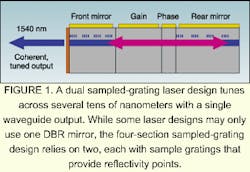By itself, DWDM does not spell success
ARLON MARTIN
As recently as five years ago, it was still common for a single optical fiber to carry just one channel at a time. A fiber of the same size can now handle in excess of 100 channels—delivering a huge increase in network capacity for both long-haul and metropolitan networks without the massive investment of laying new fiberoptic cable. The credit goes to dense wavelength-division multiplexing (DWDM), which makes it possible to propagate multiple wavelengths along a single optical fiber while maintaining the integrity of the data carried on each wavelength (see Laser Focus World, June 2000, p. 89).
The technology is not perfect, however. Most implementations of DWDM cannot consistently operate at the full theoretical capacity. Other major limitations include an inability to meet demand fluctuations, the need for a large inventory of spare lasers, and problems with wavelength blocking at optical crossconnects.
Moreover, although a DWDM network can carry many channels, it cannot carry two signals of the same wavelength simultaneously. To avoid problems, a common move is to try to identify required wavelengths based on the capacity demand pattern. When fluctuating traffic shifts this pattern, though, the fixed-wavelength laser currently used in a system may not work because that wavelength is already in use on a fiber. In networks using fixed-wavelength lasers, each node thus requires at least one dedicated laser spare for its transmitter/receiver circuit packs. The result can be millions of dollars in spare inventory.
Many carriers have managed to decrease this investment significantly by sharing spares between sites or assigning a dedicated spare wavelength to switch traffic to in case of a transmitter circuit pack failure. In this situation, the wavelength-specific spare switch-out can be scheduled into a maintenance window to avoid impacting network efficiency.
Fixed-wavelength lasers also can be limiting factors in optical crossconnect applications that may require transponders for both the input and output functions of the optical switching fabric to prevent wavelength blocking through the switch. Another problem develops when carriers demand the capability to drop and add wavelengths dynamically at more remote sites throughout a network, with the goal of changing traffic capacity and demand patterns on the fly.
Enabling bandwidth on demand
Most DWDM limitations will be addressable with the widespread deployment of tunable lasers. With such devices, which offer the potential to enable bandwidth on demand, there would be no need to commit to one wavelength specification or worry about forecasting demand for multiple wavelengths. Instead, one widely tunable device could cover the whole C-band, while another handles traffic on the L-band.
Network problems also would decrease because of improved capability to handle traffic fluctuation. Companies would simply rely on preprogrammed software to change laser channels quickly from one wavelength to another. In addition, dynamic wavelength provisioning would allow leveraging the full capacity of the network to meet peaks in demand.
Just one widely tunable laser transmitter in reserve would provide the flexibility to ensure uninterrupted transmission on the wavelength of any failed transmitter, fixed or tunable. Cost-cutting benefits also would come in the form of the capability to reduce the number of transmitter/receiver circuit packs to be supported by the network. At optical crossconnects, required transponders could drop by almost half. Such benefits can disappear, though, unless enough tunable devices are used throughout the network to realize economies of scale.
Laser selection
While tunable lasers are continuing to gain acceptance in the networking community, the technology is still relatively new and no single design system has become dominant. Some manufacturers produce lasers that can tune over a relatively limited number of channels—typically covering 10 to 15 nm. Future systems, though, should allow tuning to more than 100 channels.
One of the most promising tunable laser technologies leverages a dual sampled-grating design to achieve a range of several tens of nanometers with a single waveguide output. The four-section device uses two distributed-Bragg-reflector (DBR) mirrors instead of one (see Fig. 1). Each mirror has sample gratings that provide reflectivity points. Selection of a coarse lasing frequency occurs when current is injected into the mirror sections (see Fig. 2). Fine-tuning the laser to the required ITU frequency occurs within the gain and phase section of the device.Linewidth and modal purity of such devices can rival the best commercial distributed fiber Bragg (DFB) lasers. Manufacturers can also choose to integrate high bit-rate modulators and amplifier functions monolithically on the same platform. A wavelength range of up to 40 nm will cover either the full C-band or L-band, with support for channels featuring 50-GHz spacing and high output power.
Crucial roadblocks still remain to widespread deployment of tunable devices. For example, achieving a combination of high-volume production, low unit cost, and system reliability will probably only result when the fabrication process has been simplified somewhat. Networking companies will also most likely demand that tunable lasers demonstrate at least the same level of reliability expected from fixed-wavelength devices—if not more. Increased market infiltration will also depend on accessibility of devices from multiple suppliers, which will help ensure that supply can meet demand.
Evolving network structures
Optical networking will benefit even more from tunable lasers when systems companies evolve their infrastructures to take full advantage of the dynamic capabilities of the technology. Until these new architectures come to market, the most common function of tunable lasers will be to simplify the planning function by reducing the number of product codes to be managed.
To improve systems designs, companies will need to build their new network systems with racks of equipment and software controllers designed for lasers that can tune to any frequency. As these systems come on line, and as organizations replace their fixed-wavelength lasers with widely tunable devices, fiberoptic networks will be able to fully realize the potential of DWDM and thus dramatically boost their ability to handle both metropolitan and long-haul traffic.
Arlon Martin is vice president of marketing at Agility Communications, 600 Pine Street, Santa Barbara, CA 93117; e-mail: [email protected].

